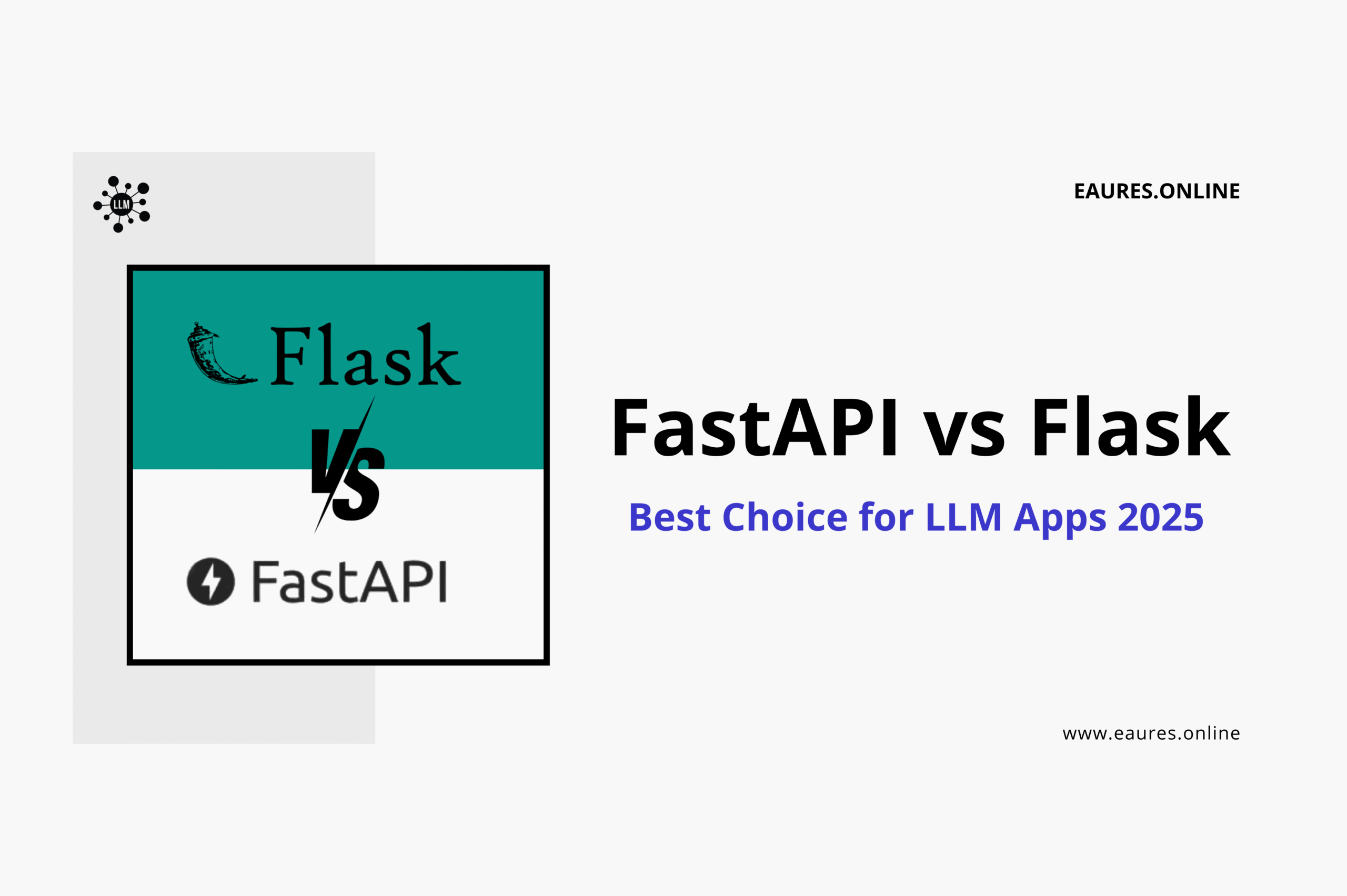Table of Contents
FastAPI vs Flask: Best Choice for LLM Apps 2025
Executive Summary: Which Is the Best Choice for LLM Apps in 2025?
For production-grade LLM applications in 2025, FastAPI is the pragmatic default thanks to first-class async I/O, type hints, automatic OpenAPI, and smooth streaming—all essential for chat UIs, RAG pipelines, and tool-calling backends. Flask remains a reliable, minimal core that some teams love for its flexibility and vast ecosystem, especially if you already run a large Flask codebase or prefer a micro-framework with minimal opinions. If you’re starting fresh with LLM workloads—choose FastAPI; if you’re extending a mature Flask stack—Flask can still be the best choice provided you add the right async and streaming shims.
FastAPI vs Flask: What “Best Choice for LLM Apps” Really Means
The LLM Workload Profile in 2025
Modern AI backends handle:
- Token streaming to UIs and SSE/WebSocket clients.
- Concurrent requests with variable model latency (local + hosted).
- RAG pipelines hitting vector stores and object storage.
- Background tasks for long-running tools, batch scoring, and evaluation.
- Observability and guardrails around PII, prompt injection, and cost.
In this reality, the framework must make non-blocking I/O, schema-first APIs, and developer feedback loops effortless. That’s where the “FastAPI vs Flask” decision becomes clear.
The Core Criteria We’ll Use
- Performance & Concurrency
- Async-first Design
- Developer Experience (DX)
- Type Safety & Contracts
- Streaming & WebSockets
- Extensibility & Ecosystem
- Security & Observability
- Deployment & Scaling
- Total Cost of Ownership (TCO)

Core Framework Differences That Matter for AI Backends
Async I/O and Concurrency
FastAPI builds on Starlette and Pydantic, embracing async def as a first-class citizen, which is crucial when you’re calling external LLM APIs and vector databases concurrently. You’ll find native async routes, dependency injection, and background tasks that simplify fan-out calls. The official docs clarify this async model well, and you can dive deeper in the FastAPI reference whenever you need to tune concurrency (see FastAPI docs).
Flask historically centered on synchronous WSGI, though you can adopt async via Werkzeug and ASGI adapters or complement it with libraries like Quart. For teams that already operate Flask at scale, this path is viable—but you’ll piece together async streaming and websockets with extra tooling (see Flask docs).
Verdict: For LLM apps with heavy I/O and streaming, FastAPI reduces friction and boilerplate.
Performance Under Real LLM Load
Raw micro-benchmarks rarely mirror reality; in the real world, your bottleneck is network I/O (to model providers, vector stores, object storage). FastAPI’s async stack helps you saturate I/O safely with fewer worker processes. Flask can match throughput if you scale horizontally with multiple workers and carefully manage greenlets/threads, but you’ll invest more time in ops.
Streaming Tokens to the Frontend
LLM UX thrives on Server-Sent Events (SSE) and sometimes WebSockets:
- FastAPI offers a straightforward path for SSE and websockets with Starlette primitives and typed dependencies (FastAPI reference). Returning an async generator that yields chunks is idiomatic.
- Flask can stream via generator responses and blueprints, but robust SSE/WebSocket support often involves additional packages or moving to an ASGI-compatible companion.
Verdict: FastAPI if your app depends on streaming chat completions and tool output.
Type Safety, Validation, and Contracts
Pydantic models, baked into FastAPI, force a clean API contract: request/response validation, automatic error messages, and consistent schema evolution. You also get OpenAPI/Swagger UIs generated automatically (FastAPI site), which is invaluable when coordinating with frontend teams and model-ops tooling. Flask can achieve parity with extensions (e.g., Marshmallow, pydantic-flask, and Flask-RESTX), but again you assemble pieces yourself.
Verdict: FastAPI wins for typed contracts and instantaneous API docs.
Developer Experience (DX) and Team Velocity
Getting to First Response Fast
- FastAPI:
uvicorn+ autoload + typing + autogen docs = fast feedback loops. The GitHub community is active and AI-focused samples abound (FastAPI on GitHub). - Flask: minimal, predictable, and time-tested. If your team knows Flask deeply, you can move quickly—especially for simple LLM proxies—but adding typing, OpenAPI, and async involves more choices.
Project Layout and Maintainability
FastAPI nudges you toward a clean domain structure (routers, dependencies, schemas). For LLM systems, that means tidy modules for RAG, providers, tools, and evaluation. Flask’s flexibility is a feature—there’s no single “right” layout—but consistency will be your team’s responsibility.
Testing and Stubs
Typed request/response models and explicit dependencies in FastAPI make it easier to mock providers, inject test doubles, and catch schema drift. Flask testing is excellent, just slightly less guided—expect to pick and standardize more testing utilities across squads.

Features LLM Teams Ask For—And How Each Framework Delivers
Token Streaming (SSE) and Chat UIs
- FastAPI: Return async generators yielding
data: ...\n\nlines for SSE, or use WebSockets for richer, bidirectional messaging. The Starlette base simplifies broadcast rooms and ping/pong keep-alives. - Flask: Generator responses for basic streaming; for SSE/WebSockets you’ll likely add extensions or adopt an ASGI helper. It works, but expect more glue.
RAG Endpoints and Multi-Tool Orchestration
- FastAPI: Concurrency with
asyncio.gatherlets you query embeddings, vector stores, and document stores in parallel. Typed DTOs keep transforms predictable, especially when you enrich prompts with metadata. - Flask: Entirely doable; your team will script concurrency patterns with threads/greenlets or add ASGI. Keep an eye on CPU-bound preprocessing—prefer background tasks.
Background Jobs and Long-Running Tools
Both ecosystems integrate well with Celery, RQ, or Arq for offloading intensive tasks. In FastAPI, it’s common to enqueue tools (crawler, PDF parsing, model fine-tuning) and stream partial results back to clients. Flask uses the same workers; ensure consistent request-scoped context when dispatching.
Observability, Tracing, and Cost Control
For LLM apps, token cost and latency percentiles are product features:
- FastAPI: Middlewares for OpenTelemetry tracing and structured logging feel natural; typed responses make redaction and PII masking easier to enforce.
- Flask: Mature logging ecosystem; add tracing libraries manually. Many teams already have battle-tested Flask observability stacks.
Security & Guardrails
Security is table stakes in 2025:
- FastAPI: Dependency injection makes authN/authZ reusable across routers. You can declare input models with allow-lists to mitigate prompt-injection adjacent payloads. See the official docs for security utilities and best practices (FastAPI docs).
- Flask: Rich ecosystem (Flask-Login, Flask-JWT-Extended) and blueprints allow fine-grained control. Apply consistent schema validation to inputs to reduce surprises.
Ecosystem, Plugins, and AI-Native Starters
Libraries and Examples
- FastAPI has become the de facto choice for new AI microservices; you’ll find many LLM app examples and templates on GitHub (see LLM application repos). The modern ASGI stack plays nicely with model gateways, vector DBs, and S3-compatible stores.
- Flask boasts a huge, mature ecosystem of extensions. If you already run Flask for non-AI services, adding LLM routes is low friction (Flask docs).
API Documentation and Client SDKs
FastAPI’s automatic OpenAPI pays dividends—frontends can generate clients, and internal platforms can discover endpoints without extra work. In Flask, you’ll typically add Flask-RESTX or apispec to reach parity.
Deployment and Scaling for LLM Traffic
Production-Ready Setups
Deploying the gateway for your LLM stack should be boring, repeatable, and cheap:
- FastAPI: Run Uvicorn/Hypercorn behind a reverse proxy. Autoscale pods by p95 latency and error rate. ASGI concurrency shines when spiking during model bursts.
- Flask: Run Gunicorn (sync or gevent) or mount via Uvicorn using ASGI adapters if you’ve adopted async. Horizontal scaling is straightforward; just be vigilant about worker configs.
For a step-by-step cloud path that includes streaming, rate limits, and cron jobs, follow an end-to-end guide like this 2025 deployment workflow for Vercel that covers AI SDK, gateways, and Next.js 15 integration for real-time UIs, which pairs naturally with FastAPI services in the backend (deploy LLM Apps on Vercel—ultimate steps).
Edge vs Region, Cold Starts, and Gateways
If your chat UI is on the edge, keep the LLM gateway in a low-latency region via a stable FastAPI service. Prefer connection reuse and HTTP/2 for streaming. Flask works too—just confirm that your adapter stack supports SSE/WebSockets without proxies closing idle streams.
Cost, Reliability, and Team Skills
Total Cost of Ownership
- FastAPI lowers code cost with typed models and auto docs, and lowers infra cost by maximizing concurrent I/O. That’s attractive when LLM API calls dominate your bill.
- Flask can match costs in steady-state if you already have platform tooling, CI templates, and staff expertise. Migration cost matters—don’t rewrite just to rewrite.
Hiring & Onboarding
Developers familiar with modern Python typing and async will be at home in FastAPI. Flask talent is abundant; onboarding remains easy, particularly for teams used to “micro-framework first” development.
Blueprint Examples: How the Same LLM Endpoint Looks
A Minimal Chat Completion Proxy (Conceptual)
- FastAPI:
async def chat()with request Pydantic model; call provider;yieldchunks to SSE. - Flask:
def chat()generator that yields chunks; add CORS, SSE headers. For parallel calls, add threads or adopt ASGI.
Both can integrate guardrails and moderation layers. For deeper prompt quality and evaluation, use a structured approach like a 7C prompt framework to standardize request payloads and improve consistency across endpoints (strongest prompts for LLMs 2025).
Decision Matrix: When FastAPI vs Flask Is the Best Choice for LLM Apps
Choose FastAPI If…
- You’re building new LLM services with chat streaming and tool-calling.
- You want async I/O without ceremony and typed contracts out of the box.
- You value auto OpenAPI, Pydantic models, and rapid API iteration (FastAPI site).
Choose Flask If…
- You have an existing Flask platform with shared extensions, observability, and CI/CD.
- Your LLM endpoints are simple (no websockets), or you’re comfortable adding async/ASGI layers as needed (Flask docs).
Mixed Strategy That Works in Practice
Run Flask for your legacy routes and spin up FastAPI microservices for AI-heavy workloads—then unify them behind your API gateway. This hybrid approach preserves momentum while you modernize.

Production Patterns for 2025 LLM Apps
RAG and Data Pipelines
- Use FastAPI dependencies to inject vector clients and dataset handles cleanly.
- In Flask, centralize client creation in application factories; ensure connection pooling for embeddings and stores.
- For repeatable, end-to-end analytics and reporting with Python + LLMs, consider a dedicated automation pattern that validates, profiles, and summarizes data before inference (automate data analysis with Python + LLMs).
Evaluation and Model Choice
A/B models and log outcomes by task. For an overview of open-model trade-offs (speed, license, cost), study a comparative face-off to make grounded choices for your stack (Llama 3 vs Mistral—open LLM comparison).
Documentation and Team Handoffs
- FastAPI: Rely on the autogenerated docs for frontend collaboration and QA.
- Flask: Add apispec/Swagger to reduce back-and-forth and ensure clients remain in sync.
Implementation Starter Kit (Links & References)
- FastAPI official docs for async routes, validation, security, and OpenAPI: read the guides and recipes to cement best practices (FastAPI docs).
- FastAPI GitHub examples and issues often cover real-world streaming and concurrency patterns (FastAPI GitHub).
- Flask official docs for blueprints, config, and streaming responses (Flask docs).
- LLM application topic on GitHub to scan common architectures and boilerplates (LLM apps on GitHub).
- FastAPI devdocs quick references for building and testing APIs rapidly (DevDocs FastAPI).
The Bottom Line for 2025
If you’re asking “FastAPI vs Flask: Best Choice for LLM Apps?” the rule of thumb is simple:
- New builds: choose FastAPI for async-first design, streaming, and typed contracts.
- Existing Flask shops: stay with Flask where it’s efficient, and offload AI-intensive routes to FastAPI services as needed.
Either way, invest in structured prompts, streaming UX, observability, and clear API contracts—these levers move your LLM product metrics more than any single framework choice. Ship value fast, measure cost per task, and keep the door open to swap models as the landscape evolves.
Operational Playbook for LLM Backends in 2025
SLOs, Rate Limits, and Retries
For teams comparing FastAPI vs Flask in real production, the deciding factor often isn’t raw speed but how easily you can enforce SLOs. Define a target p95 latency per endpoint (for example, 1.5–2.0 seconds for short Q&A, 4–6 seconds for RAG with retrieval) and wire up budget-based rate limits. In an async-first service like FastAPI, it’s straightforward to add exponential backoff and circuit breakers around upstream model providers and vector stores, reducing cascading failures when a region degrades. Flask can achieve the same guarantees via blueprints and middleware, but you’ll typically bring your own extensions and write more glue code to ensure idempotent retries for tool calls and chunked streaming.
Queueing, Backpressure, and Work Isolation
LLM bursts are notoriously spiky. Use a bounded worker pool and push overflow to a message queue so that interactive chat traffic never competes with heavy batch jobs. With FastAPI, background tasks (or Celery/Arq/RQ) pair naturally with typed payloads, making it easy to serialize work units and enforce max concurrency per tool. Flask follows the same architecture but benefits from a firm convention: isolate ingestion, retrieval, and inference into separate processes so you can apply different autoscaling and memory limits per stage without starving the main request handlers.
Streaming Integrity and Client UX
Regardless of framework, user trust hinges on smooth token streaming. Send structured SSE events—start, delta, tool, metrics, end—so clients can render partial answers and error states gracefully. FastAPI’s ASGI foundation simplifies backpressure handling and keeps the event loop responsive under load. Flask can stream via generator responses; just ensure your proxy and timeouts are tuned so long-lived connections aren’t dropped mid-completion. Whichever path you take, treat streaming as a first-class contract with explicit timeouts, partial failure semantics, and reconnect hints for the frontend.
Security Hardening for AI Endpoints
Input Validation, Output Filtering, and Policy Hooks
Security in LLM services is as much about data contracts as it is about auth. With FastAPI, Pydantic models let you whitelist fields (prompt, context, attachments) and reject unexpected inputs before they ever reach your chain. You can then add output filters to redact secrets, emails, or IDs from generated text. Flask supports the same controls through schema libraries; the key is adopting a uniform model layer and logging every reject with a reason code. Insert policy hooks (function decorators or dependencies) that run prompt-injection screening, URL allow-lists, and content policy checks on both request and response paths, not just at the edge.
AuthN/Z, Secrets, and Tenant Isolation
For multi-tenant LLM apps, enforce per-tenant API keys and ideally short-lived tokens tied to a claims set (model access, rate tier, data domains). FastAPI’s dependency injection encourages reusing the same auth guard across routers; once decoded, attach a tenant context to the request for consistent row-level filtering in vector stores. In Flask, blueprints plus a request context global work well—just be explicit about secret sourcing (environment/manager), key rotation, and least privilege for any cloud role that can touch embeddings, logs, or prompt caches.
Observability and Forensics
Plan for incidents: log prompt, model, truncated outputs, tokens used, latency, cache hits, and tool call traces with a consistent schema. With FastAPI, middlewares make it simple to emit OpenTelemetry spans per phase (retrieve → augment → infer → stream). Flask can do the same via WSGI/ASGI middlewares; the essential part is sampling. Store a small, privacy-scrubbed sample of full traces so you can replay failures or regressions without exposing sensitive data.
Case Study: Evolving a Flask Platform with FastAPI Microservices
Starting Point
Imagine a team with a stable Flask monolith powering dashboards and CRUD APIs. They want to add chat, RAG, and tool calling without risking existing SLAs. The practical path is a hybrid architecture: keep the monolith for business workflows and ship a FastAPI microservice dedicated to LLM traffic. An API gateway fronts both, routing /chat/* and /rag/* to the new service while /admin/* and legacy endpoints remain in Flask.
Migration Steps That Minimize Risk
- Freeze contracts: define typed request/response schemas for the LLM endpoints.
- Stand up FastAPI: implement streaming SSE/WebSockets, retries, and cost meters.
- Shadow traffic: mirror 1–5% of production queries to validate outputs and latency.
- Progressive cutover: move read-only queries first, then tool-calling flows.
- Decompose slowly: as RAG matures, extract document ingestion into its own worker service and scale independently.
Results
This pattern avoids a “big rewrite” while unlocking async concurrency, clean OpenAPI docs, and fine-grained autoscaling where it matters most. Over time, teams often keep Flask for back-office routes and rely on FastAPI for AI-intensive workloads—the pragmatic answer to FastAPI vs Flask when total cost and stability matter.

Reliability Patterns That Reduce Cost
Caching, Cold Starts, and Model Roulette
Introduce a two-layer cache: request-level (semantic or fingerprint-based) to skip identical prompts and retrieval cache to avoid re-querying vector stores. For hosted models, proactively manage cold starts by pinning warm pools or sending periodic “keep warm” probes. Implement model roulette (fallback chains) where cheaper models handle easy requests, while harder prompts escalate to stronger or domain-fine-tuned models. FastAPI’s async orchestration makes these policies straightforward; Flask can implement the same with clear task separation and some concurrency helpers.
Guarded Tool Use and Cost Budgets
Tool calling multiplies risk and spend. Add per-tool budgets (time, tokens) and aggregate them into a request-level cost ceiling so one wild prompt cannot run ten crawlers and a vector rebuild. Record tool outcomes with a standard envelope—name, args, duration, stdout/stderr, cost_estimate—to drive weekly governance and safe defaults. Over a quarter, these small controls often cut inference spend by 15–30% without hurting satisfaction.
Team Topologies and DX
Who Owns Prompts, Who Owns APIs?
High-performing teams split responsibilities: prompt engineers or product-minded devs own templates, evaluation datasets, and guardrails, while platform engineers own routers, schemas, and reliability. In FastAPI, schemas and dependencies give prompt engineers a stable interface to ship improvements safely. In Flask, set clear module boundaries and CI rules that block “prompt-only” changes from touching routing or security code. Either way, this clarity turns “framework choice” into team velocity, which is ultimately the Best Choice for LLM Apps outcome that leadership cares about.
Documentation That Actually Gets Read
Auto-generated OpenAPI (a natural FastAPI benefit) becomes the living contract between backend and frontend. When using Flask, invest in apispec/Swagger and publish the spec alongside sample curl/HTTPie and streaming examples. Developers copy working examples; UI polish on docs is not vanity—it’s a measurable reduction in DM questions, mis-typed payloads, and staging bugs.
FAQ: The Practical Debates
“Is Flask dead for AI backends?”
Absolutely not. Flask remains excellent for teams with an established ecosystem. The point is that FastAPI’s async primitives and typed contracts align more naturally with today’s LLM traffic patterns. Many organizations run both successfully.
“Do we need WebSockets or are SSE enough?”
For one-way token streaming, SSE is simpler and friendlier to proxies. Use WebSockets when you need bi-directional updates (live tools, collaborative editing). FastAPI supports both cleanly; Flask can do both with the right extensions and infra settings.
“Should we rewrite everything into FastAPI?”
Avoid rewrites. Extract AI-heavy endpoints first, keep the rest in Flask, and move at the pace of value. Let observability and SLOs guide the next extraction, not aesthetics.
Final Takeaway
Viewed through the lens of real operations—SLOs, streaming fidelity, cost control, and team boundaries—the FastAPI vs Flask question in 2025 has a pragmatic answer: use FastAPI by default for new LLM services, and augment existing Flask platforms with targeted FastAPI microservices where async concurrency and typed contracts provide outsized returns. This blended strategy turns framework nuance into measurable product velocity, which is the true Best Choice for LLM Apps.





Discover your perfect shades with [url=https://color-analysis-quiz.org]what season am i[/url] and find your unique color palette.
Finally, let’s discuss how to choose a reliable online service for personal color analysis.
Когда вы планируете путешествие по России и Европе, обязательно нужно учитывать находящиеся рядом к вашим маршрутам центры транспорта. В частности, такие узлы как Ленинградский вокзал и Вокзал Восточный в Москве создают беспроблемное сообщение с направлениями на Ивантеевку, Химки и Рязань, а также с иностранными рейсами в Италию, Швейцарию, Хорватию, Словакию и Польшу. Для поехдок в Крым и юг страны необходимо посмотреть на ж/д вокзал Адлер и направление Домодедово город. Дополнительно, зачастую спрашивают про подключение к метро, например, станции Патриаршие пруды метро, которая просто связана с другими районами столицы.
Если занимают более дальние поездки или туры, стоит рассмотреть маршруты из Калининграда в Зеленоградск или турне по России с посещением Байкальска, Истра или Гуниба. Для тех, кто хочет больше деталей и расписаний, предписываю изучить расписание и альтернативы маршрутов на практичном портале [url=https://travel4all.org/]москва рязань[/url] . Это крайне полезно при планировании поездок из Москвы в Тулу или Зеленоград, где существенно знать четкое время отправления и возможности пересадок.